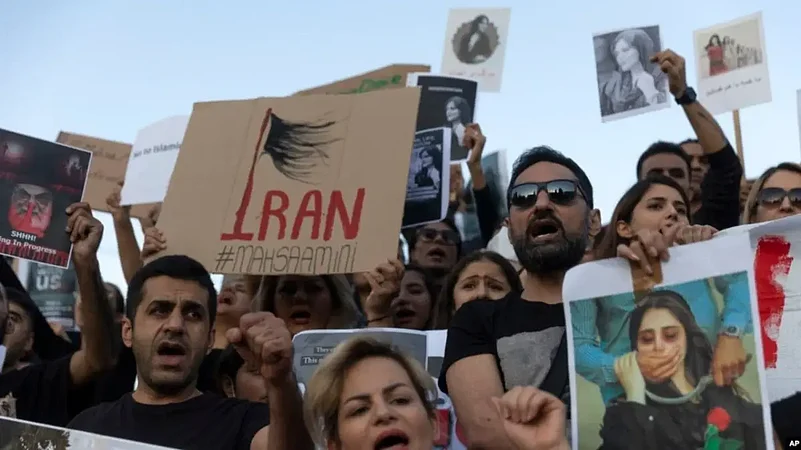The image of a flag made of hair chopped off a woman's head has come to symbolize the defiance and anger of Iranian women.
At least 11 people have been killed since protests began earlier this month after the funeral of 22-year-old Mahsa Amini, who died in custody after being detained by Iran's morality police.
“They (Iranian women) have been ignored for years and years,” she said. “That is why they are angry. Iranian women are furious now," exiled Iranian author Masih Alinejad told the Associated Press.
The protests have also stoked an only too familiar debate about enforcing the hijab and the larger issue of women's bodily autonomy.
What is happening in Iran?
Amini's death has spurred an explosion of outrage. She had been detained on September 13 for allegedly wearing her hijab too loosely in violation of strictures demanding women in public wear the Islamic headscarves. She died three days later in police custody; authorities said she had a heart attack but hadn't been harmed. Her family has disputed that, leading to a public outcry.
Protests started after her September 17 funeral, and have taken place in more than a dozen cities. The unrest spread across the country as women burned their headscarves to protest laws that force women to wear the hijab and also cut off their hair. It is illegal for hair to fly without a headscarf in Iran.
The Iranian government has pushed back, clashing with demonstrators and clamping down on internet access.
The demonstrations surrounding the death of Amini — and the government crackdown emerging to stifle them — represent just the latest cycle of unrest to grip Iran since its 1979 Islamic Revolution. And are not likely to be the last for Teheran.
The incidents in Iran, however, are significant for the world and they will influence the roles and rights of women in Muslim societies across other countries as well.
Arab world taking notice
The enforcement of the hijab and, by extension, guardianship over women’s bodies and minds, are not exclusive to Iran. They manifest in different forms and degrees in many countries.
Unlike in Iran, the forced wearing of the hijab is unconstitutional in Iraq. However, the ambiguity and contradictions of much of the constitution, particularly Article 2 about Islam being the primary source of legislation, has enabled the condition of forced hijab.
Since the 1990s, when Saddam Hussein launched his Faith Campaign in response to economic sanctions imposed by the UN security council, pressure on women to wear the hijab has become widespread. Following the US-led invasion of the country, the situation worsened under the rule of Islamist parties, many of whom have close ties to Iran.
Contrary to the claim in 2004 by US president George W Bush that Iraqi people were “now learning the blessings of freedom”, women have been enduring the heavy hand of patriarchy perpetuated by Islamism, militarisation and tribalism, and exacerbated by the influence of Iran.
While Iran is in a state of commotion, the protests have also attracted attention in the Arab world including Iraq and women are gathering online to offer solidarity to Iranian women struggling under the country’s harsh theocratic regime. However, the conservative backlash has also been persistent and intense. Iraqi Shia cleric, Ayad Jamal al-Dinn, for instance, lashed out against the protests on his Twitter account, labelling the protesting Iranian women “anti-hijab whores” who are seeking to destroy Islam and culture.
Hijab debate in India
Indians on social media have also been actively supporting women in Iran with many sharing images and messages of solidarity.
While the protests in Iran have been against the headscarf, Muslim women in India are fighting for their right to wear the hijab after the government of Karnataka banned wearing clothes that disturb equality, integrity, and public order in schools and colleges in February this year.
A number of counsel appearing in court for Muslim women who have petitioned against the ban insisted have insisted that preventing them from wearing the hijab to the classroom will put their education in jeopardy as they might stop attending classes. While the Karnataka government has insisted the state government’s circular was “religion-neutral” with no reference to the hijab, counsel appearing for the Muslim side in court have argued that there is a pattern of targeting minorities in the government's ban.
Critics of the hijab associated it with oppression state that a ban on Hijab will be empowering for women. However, those in favour of revoking the ban state that education is empowerment and that if Muslim girl students get a better education, they can make a conscious and informed decision in future on how they want to dress. Critics of the current government as well as Muslim academics and activists have also expressed fears that the ban on hijabs in India is a veiled attempt to reduce Muslim presence and way of life in public spaces.
Forced Hijab vs Hijab Ban
Women who use their social media accounts to reject the hijab are often met with sexist attacks and threats that attempt to shame and silence them.
Those who openly speak about their decision to take off the hijab receive the harshest reaction. The hijab is linked to women’s honour and chastity, so removing it is seen as defiance.
Women’s struggle with the forced hijab and the backlash against them challenges the prevailing cultural narrative that says wearing the hijab is a free choice. While many women freely decide whether to wear it or not, others are obliged to wear it.
So academics need to revisit the discourse around the hijab and the conditions perpetuating the mandatory wearing of it. In doing so it is important to move away from the false dichotomies of culture versus religion, or the local versus the western, which obscure rather than illuminate the root causes of forced hijab.
(With inputs from Agencies)

















